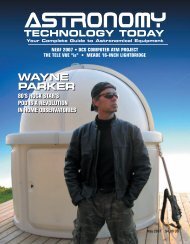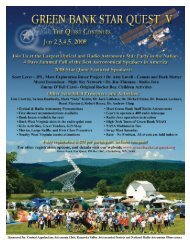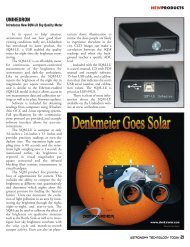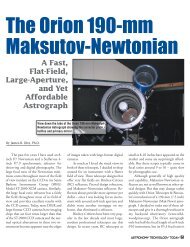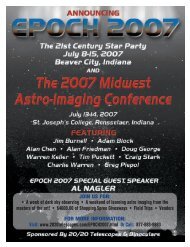Mike Jones article.qxd:Layout 1 - Astronomy Technology Today
Mike Jones article.qxd:Layout 1 - Astronomy Technology Today
Mike Jones article.qxd:Layout 1 - Astronomy Technology Today
You also want an ePaper? Increase the reach of your titles
YUMPU automatically turns print PDFs into web optimized ePapers that Google loves.
BAFFLE OPTIMIZATION FOR CASSEGRAIN TELESCOPESFigure 7. Non-optimal baffling showing separation between planes P 12 , P 13 and P 23 .bring planes P 12 , P 13 and P 23 tocoplanarity. Figure 8 shows theimplementation.The horizontal axis is the value of thelength of the secondary baffle TBS. Thevertical axis is the difference between thedistance d 1 =d 12-13 between planes P 12–P 13 and the distance d 2 =d 13-23 betweenP 13 -P 23 along the optical axis.The initial value for TBS gives the differencebetween d 1 and d 2 . A small differentialvalue, say 0.001", is added to TBSand the subroutine to calculate the d 1 -d 2difference is called again. This gives a newdifference value shown as d 2 . The linearprojection of this line to the horizontalaxis at d 1 -d 2 =0 gives the estimated valueof TBS required to bring the two planesto coplanarity. This value is added to theinitial value of TBS, and the differencevalue is re-calculated.If both mirror surfaces were approximatedas planes as in Prescott’s paper, thistechnique would give the exact length ofthe secondary baffle tube in one linear solutioncycle. But because both mirror surfacesare aspherically curved, the linearprojection step is an approximation to theoptimal value, and the process must be repeateda few times until convergence isreached. Four to five cycles has shown tobe enough in all cases tested, even for veryfast, strongly aspheric Cassegrain primar-56 <strong>Astronomy</strong> TECHNOLOGY TODAY



